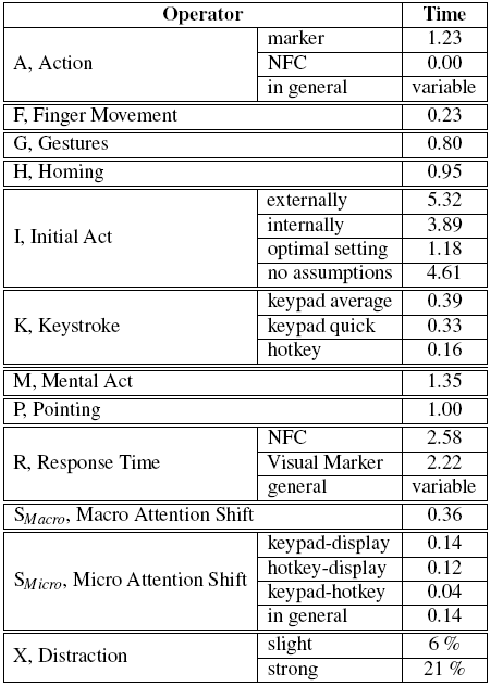
In this exercise you will learn and use the Keystroke-Level-Model: an interface evaluation technique, based on GOMS (Goals, Objects, Methods, Selection rules).
You will be using a mobile phone belonging to one of your group. Make sure that it is has the necessary features as outlined below.
Model each of the three tasks described below using the KLM as presented in the lecture/exercise. Give a list of operators with comments indicating what step you are currently modeling. Give the sum of the modeled time. Use a spreadsheet program like Excel to speed up the calculation and avoid errors.
Let 3 people of your group do each task at least twice. Measure all times and write all of them (not only averages) down in a table. If a task has several steps (e.g. take picture + send MMS) write down separate measurements and a total result. Compare your results with the times predicted by the model and explain possible differences. Comments on the model and its parameters are welcome.
A summary and explanation as well as placement guidelines of the KLM operators will be given at the end of this exercise sheet. See also Holleis et al: Keystroke-Level Model for Advanced Mobile Phone Interaction
Hand in a report (two pages) describing in detail your model and experimental study. Also hand in raw data.Tasks:

Action (A): Any special action that is executed with the phone. Examples include taking a picture (marker), using NFC, etc.
Finger Movement (F): Movement from one position (button) to another. Normally already included in K (Keystroke operator).
Homing (H): Movement of the phone from a position close to one’s ear (listening/talking) to a position where one can read the screen.
Initial Act (I): Time needed from the moment an interaction is planned (incoming call, wish to call someone, etc.) to the real start of interaction (button press etc.).
Pointing (P): Physical movement of the phone to a specific place, e.g. to initiate some Action A there.
System Response Time (R): The time needed by the system to react to user input.
Macro Attention Shift (SMacro): Time needed when the attention (gaze/look) changes from the phone to an object in the real world or back.
Micro Attention Shift (SMicro): Attention shifts between display, hotkey region and keypad region, e.g. when the user has to explicitly verify text input.
Distraction (X): Add 6% / 21% of the time to all operators that happen when the user is slightly / strongly distracted from the task.
Mental Act (M): The Mental Act operator is supposed to capture peoples’ need to reflect on executed actions, interpret system responses and plan further actions.
The following guidelines should help in placing operators. Use Rule 0 to place candidate M’s and then cycle through Rules 1 to 5 for each M to see whether it should be deleted.
Rule 0: Place M’s in front of all K’s, H’s, SMacro’s and G’s.
Rule 1: If an operator following an M is anticipated in the operator before the M, delete the M (e.g., PMK becomes PK).
Rule 2: If a string of MKs belongs to a cognitive unit (e.g., writing a known number), then delete all M’s but the first.
Rule 3: If a K is a redundant terminator (e.g., the selection key for entering submenus), then delete the M in front of it.
Rule 4: Delete the M in front of an H which describes the movement from the reading to the listening position.
Rule 5: If unsure, emphasize the number rather than the placement of the occurrences of the M operator.
./Do not use any other directory layout.
9/
a/
summary.txt
b/
further_questions.txt
10/
report.pdf
raw_data.txt